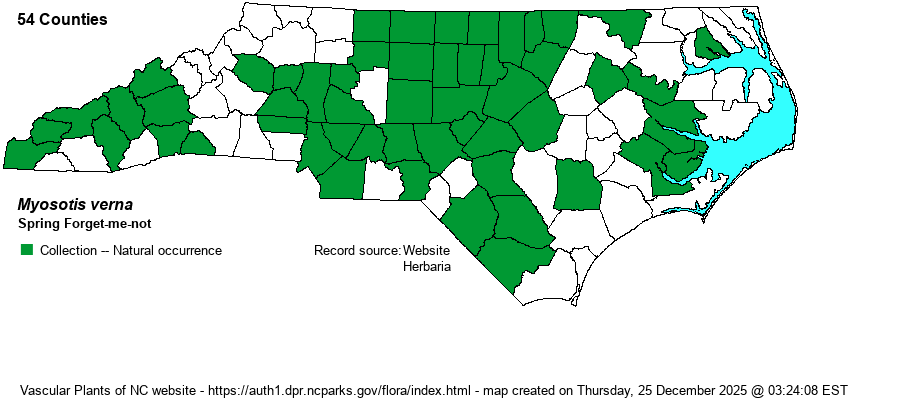| Author | Nuttall | |
| Distribution | Present over most of the state, particularly throughout the central and eastern Piedmont. Widely scattered in the central and eastern Coastal Plain and in the northern Mountains.
This is a widespread species across the U.S., ranging from southern Canada south to northern FL (very rare) and central TX; also in some far Western states. | |
| Abundance | Fairly common at best now in the central and eastern Piedmont, though has clearly declined in recent decades; formerly more common. It is uncommon in the western and central Coastal Plain, and very rare toward the coast. Uncommon in the central and southern Mountains, but rare to absent in the northern ones. The species may have been more numerous in NC than M. macrosperma from 1975 and earlier, but the latter species is much more often encountered nowadays. | |
| Habitat | This is a species of dry and mostly sunny to lightly shaded places. It grows along upland wooded borders and openings, dry and overgrown fields, in powerline clearings, and other similar places. However, some collections are from creek margins, and thus on some occasions in can be found in disturbed damp ground. | |
| Phenology | Blooms from March to July, mainly through May, and fruits soon after flowering; withers shortly after fruiting. | |
| Identification | This is a smaller and more pubescent version of M. macrosperma, and they have many features in common. M. verna grows mostly just to 8 inches tall, seldom more than 1 foot tall, whereas the other species usually reaches 1.5-2 feet tall. It usually has a few branches from the upper stem. The alternate leaves are oblanceolate to almost linear, about 1.5 inches long and barely 1/4-inch wide. The short racemes of flowers grow at the branch tips. The very small white flowers are barely 1/10-inch across, with 5 lobes; they grow fairly close together, typically less than 2/5-inch (1 cm) apart. The flowers in M. macrosperma grow farther apart, and lower ones are often 4/5-inch (2 cm) apart. In M. verna, the fruit stalks are ascending such that the fruit is somewhat erect, whereas those in M. macrosperma are divergent such that the fruiting stalks are almost perpendicular to the raceme axis. In summary, a small, white-flowered forget-me-not growing in dry habitats should be this one, but you still need to check out the flowers and fruit characters to be sure, as M. verna at times grows in damp/low places. | |
| Taxonomic Comments | None
| |
| Other Common Name(s) | Early Forget-me-not, Spring Scorpion-grass | |
| State Rank | S4 | |
| Global Rank | G5 | |
| State Status | | |
| US Status | | |
| USACE-agcp | FACU link |
| USACE-emp | FAC link |

